An authentic and positive customer review is more than just a feather in your cap; it is a powerful instrument that can boost your sales, drive customer confidence, and increase conversions.🚀
In an era where word-of-mouth marketing has gone digital, testimonials have taken center stage. They are the trust signals that can influence the buying decisions of potential customers and nudge them towards choosing your products or services. But how exactly do testimonials help in driving sales, and what is their role in boosting customer confidence? Let’s dive into this captivating topic.🔍
Understanding the Power of Testimonials
A happy customer can be the most effective brand ambassador for your business. Testimonials can bring life to your product or service, showcasing it in a real-world context. They provide credibility to your claims and prove that your product delivers value as promised.🌟 They are not just reviews; they are stories that resonate with potential customers. They offer a relatable narrative that potential buyers can identify with, reinforcing their confidence in your offering.
The Impact of Testimonials on Sales and Conversions
Testimonials can dramatically impact your sales and conversions. Think of them as silent salespeople, always ready to vouch for your product or service. They offer reassurances to prospective buyers, eliminate doubts, and address potential concerns.🛡️ A prospective customer, seeing a positive review from a satisfied user, is more likely to feel confident about their potential purchase. This, in turn, increases the likelihood of conversions.
The Role of Testimonials in Building Customer Confidence
As consumers, we naturally seek validation from our peers. When making a purchase decision, we’re more likely to trust the opinion of a fellow customer than a sales pitch. Testimonials fill this need for peer validation.🔑 They provide authentic feedback from real users, building customer confidence and making the decision-making process easier. They offer a sense of assurance, reinforcing the belief that they’re making the right choice.
In the upcoming sections, we will delve into the strategic use of testimonials, exploring how to effectively collect, manage, and display these nuggets of gold. We’ll also examine the crucial role of testimonials in SEO and how they can significantly improve your search engine rankings.📈
Moreover, we’ll take a deep dive into the psychology behind testimonials and their impact on potential customers. You’ll learn about the influence of social proof in shaping customer perceptions and the role of positive reinforcement in driving sales.💡
So get ready to unlock the power of testimonials and leverage them to their full potential. With the right strategy, they can become your most potent weapon, driving your sales and boosting customer confidence. Let’s embark on this insightful journey!🚀
Unlock the Power of Testimonials: Building Trust to Amplify Your Sales
As the realm of e-commerce continues to expand and evolve, the age-old marketing technique of utilizing testimonials remains a proven strategy to boost sales and improve conversion rates. A Rave Review is more than just a pat on the back; it is a powerful social proof that instills customer confidence and trust in your products or services. 🚀
Customers today are more discerning than ever. They tend to rely heavily on user reviews and testimonials when deciding whether to make a purchase. According to a study by BrightLocal, 91% of consumers are more likely to use a business that has positive reviews. This article will delve into how testimonials can be used effectively to drive customer confidence and increase conversions.
Understanding the Impact of Testimonials on Consumer Behavior
Testimonials have a direct impact on consumer behavior by influencing their purchase decisions. They provide tangible evidence of a product’s or service’s quality, thereby reducing the perceived risk associated with the purchase. This, in turn, increases the likelihood of a purchase being made.
Moreover, testimonials are a form of word-of-mouth marketing. They leverage the principle of social proof, which states that people tend to conform to the actions of others under the assumption that those actions are reflective of the correct behavior. When potential customers see others praising your product or service, they are more likely to follow suit.
To further illustrate the power of testimonials, let’s take a look at the table below, which presents a comparative analysis of conversion rates with and without the use of testimonials:
| Without Testimonials | With Testimonials |
|---|---|
| 1.3% Conversion Rate | 3.7% Conversion Rate |
🎥 Video Highlight: The Power of Social Proof in Marketing
For a more detailed understanding of how social proof works, check out this insightful video by “Charisma on Command” titled “The Science of Social Proof: How to Influence Others to Do What You Want”.
How to Generate and Use Rave Reviews Effectively
Generating rave reviews requires a strategic approach, starting from delivering an exceptional customer experience to proactively asking for feedback. Remember, a satisfied customer is your best advocate. Here are some tips on how to generate and use rave reviews effectively:
- Provide Exceptional Service: The foundation of rave reviews is exceptional service. Exceed your customers’ expectations, and they’ll be more likely to leave a positive review.
- Ask for Feedback: Don’t wait for customers to leave a review. Instead, be proactive and ask them for their feedback. This could be done through follow-up emails or surveys.
- Respond to Reviews: Show appreciation for positive reviews by thanking the reviewer. For negative reviews, respond professionally and try to resolve the issue. This shows potential customers that you care about their experience.
- Display Reviews Prominently: Make sure your reviews are easy to find. Place them on your homepage, product pages, and even in your marketing emails.
Remember, authenticity is key when it comes to testimonials. Fake or doctored reviews can damage your reputation and turn customers away. Always ensure your reviews are genuine and representative of your customer experiences.
Transforming Reviews into Conversions
Turning positive reviews into conversions is a critical step in leveraging the power of testimonials. It’s not enough to just collect and display testimonials; you need to use them strategically to convince potential customers to take action.
One effective way of doing this is through storytelling. Rather than just presenting a quote, share a story of how your product or service helped a customer. This can make the testimonial more engaging and relatable, thereby increasing its persuasive power. For instance, video testimonials can be a powerful medium for storytelling, as they allow potential customers to see and hear directly from satisfied customers.
Furthermore, testimonials can be used to overcome specific objections or concerns that potential customers may have. For example, if potential customers are concerned about the quality of your product, you could highlight testimonials that specifically praise the product’s quality.
🎥 Video Highlight: Transforming Testimonials into Conversions
For an in-depth look at how to transform testimonials into conversions, watch this informative video by “DigitalMarketer” titled “How to Use Testimonials to Close More Sales”.
In conclusion, testimonials are a powerful tool for boosting sales and increasing conversions. By building trust and reducing purchase risk, they can significantly influence consumer behavior. So, start harnessing the power of rave reviews today and watch your sales soar! 🚀

Conclusion
In conclusion, the technical aspects we’ve explored throughout this article not only underline the integral role of IT and engineering in today’s digital landscape but also highlight the complexities involved. These complexities, whether related to intricate coding paradigms or sophisticated engineering processes, hold the key to understanding and successfully navigating the technicalities that define our digital world.
A recapitulation of our discussions inevitably brings us back to the importance of technical writing. As we’ve established, this skill lies at the intersection of IT and engineering, bridging the gap between technical information and its comprehension. Through technical writing, concepts that seem esoteric at first glance become more approachable, fostering a broader understanding and application.
We’ve also dived into the relevance of my academic background in Software Engineering. This background has not only been instrumental in understanding the nuances of technical writing but also paved the way for my decade-long journey as a technical writer. As such, this journey has been marked by structuring articles that are both informative and engaging, catering to a specialized audience.
As we look back at these points, we’re reminded of the intricate tapestry that IT and engineering weave together. Their interplay not only shapes the backbone of our digital society but also emphasizes the importance of communicating these technicalities effectively. This importance, in turn, underscores the role of technical writing and the value it brings to the table.
With this conclusion, I hope to have instilled in you a deeper understanding of the topics at hand. Moreover, I hope to have inspired you to delve into these areas, be it as a reader, a commentator, or even as a practitioner. Your engagement and interaction are what fuel this exploration of knowledge, making it a more enriching experience.
I encourage you to comment, share, or apply what you’ve learned from this article. It is through this engagement that we can create a thriving community of technical enthusiasts, each contributing to the collective pool of knowledge in their unique ways.
As we draw this discussion to a close, I invite you to revisit the points we’ve tackled. Feel free to explore the various resources linked throughout the article. These resources not only corroborate the points discussed but also serve as a gateway for further exploration.
Thank you for joining me on this intellectual journey. I look forward to hearing your thoughts, insights, and experiences as we continue to explore the digital landscape together. Remember, the beauty of knowledge lies in its exchange, and every comment, share, or application of this information contributes to that exchange.
As always, your interaction is not only appreciated, but it is also the driving force behind our exploration. Let’s continue to learn and grow together, delving into the complexities of IT and engineering and unraveling the nuances that lie within. 😉
References:
[Link to source 1](#)
[Link to source 2](#)
[Link to source 3](#)
This article was originally published on [website name](#) and has been republished here with permission.
I hope you found this article helpful. If you did, please feel free to share it with your network. And don’t forget to subscribe to our newsletter for more technical insights! 🚀



